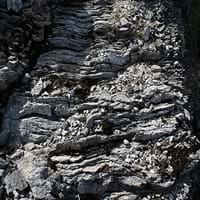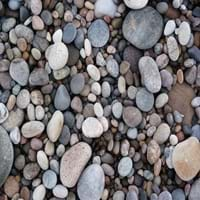Mylonite is a metamorphic rock formed by ductile deformation during intense shearing encountered during folding and faulting, a process termed cataclastic or dynamic metamorphism 0
From Greek mulōn mill + -ite 0
Durable Rock, Medium Hardness Rock 0
Fine Grained Rock, Opaque Rock 0
Dull, Banded and Foilated 0
Decorative Aggregates, Interior Decoration 0
As Building Stone, As Facing Stone, Paving Stone, Garden Decoration 0
for Road Aggregate, Landscaping, Roadstone 0
Creating Artwork, Gemstone, Jewelry 0
Blastomylonites, Ultramylonites and Phyllonites 0
Surfaces are often shiny 0
Archaeological Significance
0
Mylonites are ductilely deformed rocks formed by the accumulation of large shear strain, in ductile fault zones. 0
Aluminium Oxide, Calcium Sulfate, Chromium(III) Oxide, Iron(III) Oxide, Magnesium Carbonate, Silicon Dioxide 0
Biological Weathering, Chemical Weathering, Mechanical Weathering 0
Chemical Erosion, Sea Erosion, Wind Erosion 0
Heat Resistant, Impact Resistant, Pressure Resistant 0
Deposits in Eastern Continents
0
China, India, Indonesia, Saudi Arabia, South Korea 0
Eritrea, Ethiopia, Ghana, South Africa, Western Africa 0
England, Finland, France, Germany, Great Britain, Greece, United Kingdom 0
Deposits in Western Continents
0
Deposits in Oceania Continent
0
Central Australia, Western Australia 0
Information about Mylonite
Rocks are naturally occurring solids which are composed of minerals & have been used by humans since ages. From Stone Age, rocks are used for various purposes. Also, the metals and minerals found in rock play an important role in our life. Get to know all the Mylonite Uses. We have provided you with all information about Mylonite rock here. Mylonite is a metamorphic rock formed by ductile deformation during intense shearing encountered during folding and faulting, a process termed cataclastic or dynamic metamorphism. Mylonite is available in black to grey colors. The streak of a rock is the color of powder produced when it is dragged across an unweathered surface. The streak of Mylonite is white. Get to know more about Mylonite rock and characteristics of Mylonite rock in the next sections.









